A few years back, I saw a very cute ad that featured a photo of a couple of toddlers. The script read, “Come see what we saw.”
I wondered what it was that they might have seen, and then I got it: the ad was for their family’s sawmill. What they saw is lumber.
Today, that ad might read, “Come see what we saw, and chip, and plane, and dry,” but that wouldn’t quite work, would it?
All sawmills turn logs into lumber, but it would be hard these days to find a sawmill whose only product is lumber. The Northeast’s sawmills are known for turning out beautiful boards of white pine and hardwoods – maple, oak, birch, and cherry – that are used in paneling, furniture, trim and molding, flooring, and many other products where looks count. But in the process of sawing those beautiful boards, a tremendous volume of not-so-beautiful byproducts is created.
Bark gets sold for landscaping mulch. Sawdust gets sold to farmers for bedding. Pine mills that kiln-dry and plane their lumber sell the planer shavings to horse people for bedding. Slabs made from the first cuts off a debarked log get run through a chipper along with edges and other discards, and the chips are sold to paper companies.
Being able to find markets for bark, slabs, and sawdust, all of which used to be treated as waste, has become the sawmills’ key to staying alive – or even thriving – in an increasingly competitive international marketplace. In the words of one enterprising mill owner, he needs to be efficient at turning 5 board feet of log into 6 board feet of product.
Sawmills are at the center of the working forest infrastructure, and their long-term viability is crucial for maintaining the forest-based economy that is so important to the Northeast’s rural areas. From teaming up with wood-fired power plants to finding niche markets for specialty wood, the region’s mills have developed ways to make it work. Here is the story of one New England sawmill and how its business strategy has turned the concept of diversification and utilization into a fine art.
A Complicated Flow Chart
HHP, Inc., a hardwood sawmill in Henniker, New Hampshire, has three distinct product lines: they saw hardwood lumber; they buy pulpwood and chip it for paper companies; and they manufacture wood pallets.
Company president Ross D’Elia (he and Richard Carrier of Skowhegan, Maine, are each 50 percent owners) said that HHP’s level of diversification has proven to be a good strategy. “The markets for the three are totally separate. Chips have nothing to do with lumber, so we’re taking care of a whole other customer base. And pallet buyers are looking for a shipping platform for their goods. They’re not interested in lumber or chips. The philosophy is that when the market is down in one area, something else will pick it up. You’re always hoping that all three are profitable, but right now the lumber business is a challenge, and there’s a huge surplus of pulp looking for a home. Chips can turn around in a hurry, though, and pallets have been strong. At the end of the year, we get through it pretty well.”
HHP’s three operations evolved separately in three separate locations in Henniker and weren’t consolidated at one location until 1998, when HHP added 14 acres to the 25 it already owned. And while the customer base of each operation is separate, there are a number of cross links in the process, making for a very complicated flow chart of inputs and outputs. For instance, when any sawmill saws lumber, it’s not all high quality. No log will yield clear lumber from the outside to the core, and it’s always a challenge to find buyers for the knotty, narrow, and otherwise less valuable boards. HHP doesn’t have to market all of that Grade 3 lumber – which constitutes 25 percent of their output. Instead, they just forklift it 50 yards across the lot to the pallet shop, where it gets trimmed and incorporated into HHP’s custom pallets.
HHP can’t produce all the Grade 3 lumber necessary to manufacture the 25 trailer loads of pallets they ship each week. In fact, they have on hand only 20 percent of what they need. The rest comes from what could be seen as an improbable source. Said D’Elia, “We buy lumber – cants and boards for our pallets – from the same companies that we’re competing against for sawlogs. And I think they’re happy we’re there to buy the low-grade lumber and to pay in a timely fashion.”
Other connections among the three product lines include consolidating the bark that is ground off both the sawlogs and the hardwood pulp, which come in on different trucks and are processed separately, and chipping the slabs and edgings from the sawmill to augment the chip pile. But the biggest reason to run the three separate product lines is to spread out the risk. And there is plenty of risk.
In fact, there is vigorous debate among industry insiders over the long-term prospects of the industry. In the face of increasing foreign competition, rising costs for energy, and a perennial shortage of dedicated workers, it has become much more challenging for sawmills to turn a profit. According to Sarah Smith, a forest industry specialist at University of New Hampshire Cooperative Extension, a number of mills have shut their doors in the last decade, but she’s quick to point out that even though there have been closings, the overall production has been steady or has increased. She said that the mills that are staying in business are doing so partly through increasing their capacity.
D’Elia gets a rueful smile on his face when he says, “For whatever reason, we’re bullish on manufacturing in the Northeast. Sometimes I find myself scratching my head and wondering why.”
Bullish is an apt term for a company that since 1989 has invested $20 million in its manufacturing facility. Said D’Elia, “The theme is that every two years, we take a look at where we are, and take a look at how markets have changed – and they always do – and then figure out where we need to invest.”
HHP’s willingness to keep investing in infrastructure is not an anomaly in the lumber business. Sarah Smith recently completed a study of capital investments made by New Hampshire sawmills. Her 2004 study shows that the average investment by sawmills over a 10-year period was $3.4 million. Clearly, the owners of these mills see enough potential to be building up their infrastructure.
Some of HHP’s investment is decidedly low-tech. For instance, the company recently completed paving its entire yard. In a business where all forms of wood fiber have value, they can’t afford to lose any of it. By paving, they avoid having dirt or gravel contaminate any of the loads of chips or sawdust, let alone the high-end kiln-dried lumber.
But mostly, the company is spending its money on specialized equipment to increase productivity. This past year, HHP invested $4 million in these four projects:
- 3 dry kilns
- a 60-bay automated bin sorter for sorting lumber
- a second resaw line that feeds the new bin sorter
- a sterilizer in the pallet shop (exported pallets need heat treatment)
Perhaps the most noteworthy news about this investment is that none of these enhancements require hiring additional personnel. D’Elia is quick to point out that most of HHP’s investment over the years has been in the service of more automation and fewer employees. Walk into the 20,000-square-foot building that houses the sawmill, and you’ll see only four workers.
One sawyer operates the headsaw that turns the round log into a square timber, producing some slabs and some boards along the way. The timber then goes to a second sawyer operating the main resaw, so named because it makes the secondary cuts after the head saw. This 6-foot bandsaw cuts the grade boards off the outside, rotating the timber until what’s left is the center of the log, a 6-inch-by-6-inch cant. This large cant goes to the smaller resaw, where the sawyer tries to get at least one more good-quality board (#1 common) out of it. Otherwise, it’s cut into boards and cants for the pallet shop. In addition to these three sawyers is the edger man, who trims round edges off the boards cut by the head saw.
Downstream are three inspectors, who make crayon marks on the boards that are read by a scanner, which records the grade of each board and gives a cutting command to an automatic trimmer. Once they’re trimmed, the boards flow down to the bin sorter, which automatically sorts boards into designated bins of like grades and dimensions. Each week, 165,000 board feet are processed by these seven workers, who rotate through the seven positions throughout each day.
D’Elia said, “Every year we ask ourselves the question: How do we keep running efficiently with as few people as we can? We’re making these people more effective by giving them better tools to increase their capacity.”
Sales figures support D’Elia’s strategy. In 1989, with 20 employees, the company had sales of $2.5 million a year. Last year, with 50 employees, they’ve increased sales to $18 million.
If you were to ask any sawmill owner in the Northeast about labor, you would likely hear the same story: finding and keeping dependable employees is a huge challenge. A sawmill job is physical work in an industrial setting, and many new hires don’t last the week. HHP has taken advantage of its proximity to the more urban setting of greater Boston and has hired a cadre of 15 Cambodian workers, all with resident alien status, who travel to Henniker from Lowell, Massachusetts. They have proven to be eager workers who are quick to learn and to advance. At a time when at the heart of the national debate over immigration policy lies the question, “Who will do the work?”, D’Elia has no qualms about the solution he has found.
“We were having a hard time getting people to show up,” D’Elia said. “The Cambodians have a good work ethic, their attendance is excellent, they take tremendous pride in running the machinery, and they’ve worked hard to make a smooth transition to the new machinery. In a business like ours, it can be chaos on the production floor when people don’t show up. We need stability in our work force so we can stay consistent with our production and our costs. A big part of the reason to drive for more investment in automated equipment is so we don’t depend on a large labor force to get the product out.”
Labor continues to be an everyday concern, but the biggest challenge facing sawmills today is a steady, affordable supply of wood. At HHP, that responsibility falls into the hands of Don Winsor, whose job requires that he bring 10 million board feet of sawlogs and 150,000 tons of pulp into the yard each year. Where D’Elia speaks with an urban cadence and has the lean, compact build of the bike racer he is, Winsor’s slower speech and woodsman’s build bespeaks the New Hampshire woods in which he’s been chasing white-tailed deer ever since he was a boy.
“With all the improvements he’s making here, it all translates to me having to bring in more wood.” In classic New England deadpan, Winsor says, “Ross is trying to kill me.”
Except (presumably) for the last sentence, what he says is true. HHP has such a large investment in its manufacturing facility that it can’t afford to run out of raw material.
Some mills rely entirely on what’s known as “gatewood,” logs that come in (through the gates) on trucks from independent logging contractors who contact the mill, compare prices, and ship them wood when it makes good financial sense. Mills cultivate relationships with loggers they can rely on to bring them a steady stream of the kind of wood they want. But loggers need to shop around for the best prices, and for the past few years, prices have been very good. To buy those logs, mills are competing not only with other sawmills but also with buyers for the international market, particularly Canada. That stopped being a reliable system for HHP.
“We have to be in control of getting product in the door, so we don’t rely so heavily on gatewood any more. We’re buying a lot more stumpage ourselves,” said D’Elia. Eighty percent of their raw material comes from stumpage purchased directly from landowners; this move away from gatewood is a return to the way mills traditionally operated. One landowner they’ve begun to buy from is the White Mountain National Forest, having bid successfully on several of its timber sales.
“With the Forest Service timber sales, it’s like being in the futures market,” said D’Elia, “because you won’t cut the timber until long after you’ve bought it. It’s expensive to get involved. You have to put up bonds, and there’s lots of risk. But Don has lot of experience dealing with the Forest Service, so we’ve been going after sales aggressively. And it has worked out well. The quality of the wood is excellent and the volume is good.”
In most cases, they bid on timber sales and hire a logging contractor to cut and deliver the wood. Winsor is a licensed New Hampshire forester, and winter will find him supervising the work of as many as 15 logging contractors. HHP is a Sustainable Forestry Initiative (SFI) licensee, and its procurement policy requires that every job have an SFI-trained contractor. To supplement the wood from those jobs, HHP also started its own logging division by investing heavily in mechanized harvesting equipment. Knowing they wanted to be able to work lightly on the land, they bought a new Timber Pro forwarder and a CAT cut-to-length processor in 2005.
Said Winsor, “My forwarder looks huge – it can haul eight cords – but fully loaded, it has only 6 pounds per square inch of ground pressure. It allows us to work year-round. With cut-to-length, you can reach in and pick out a tree – it’s very easy on the residual stand. And because the tops stay in the woods [as opposed to whole-tree harvesting], you’re running on tops – it has very low impact.” This one crew produces 25 percent of the volume for the chip mill, which helps take the ups and downs out of the search for wood. And in a further effort to maintain control over his procurement costs, D’Elia envisions adding to this logging capacity in the future.
In a way, the story of HHP can be told through the trucks that enter and exit the yard each week. Coming into the yard in an average week are 50 truckloads of logs, 100 loads of pulpwood, and 10 to 12 loads of stock for pallets.
Leaving the yard and loaded with product are a comparable number of trucks carrying an array of products that include: hemlock bark; hardwood bark; sawdust; hemlock chips; hardwood chips; white wood chips (they include no oak or cherry); veneer logs (which are worth more being re-sold than sawn); roundwood pulp; green hardwood lumber; kiln-dried hardwood lumber; and wooden pallets in more than 100 patterns.
From the looks of it, they must be getting close to getting 6 feet of product out of 5 feet of logs.


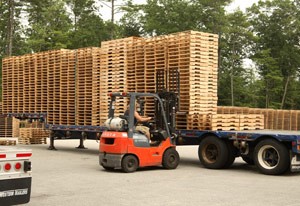
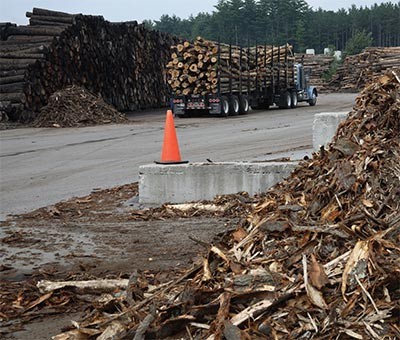
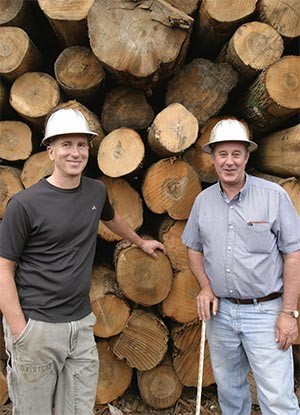
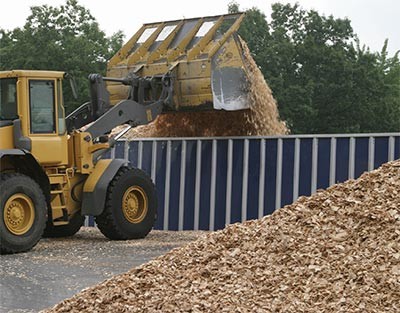
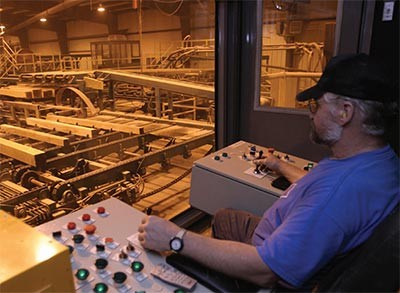

Discussion *